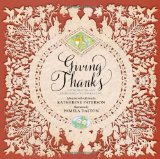Review of Maude, The Not-So-Noticeable Shrimpton, by Lauren Child and Trisha Krauss
The Not-So-Noticeable Shrimpton
by Lauren Child
illustrated by Trisha Krauss
Candlewick Press, 2013. First published in the United Kingdom in 2012. 32 pages.
Starred Review
Maude Shrimpton is part of a family who loves to be noticed. Each member of the Shrimpton family is “so talented, so eccentric, so larger than life . . . you just couldn’t miss them even if you wanted to.”
Well, each member — except Maude.
In all the pictures, Maude’s clothes blend in with whatever she’s standing in front of. (These are positively brilliant!) “When Maude crossed the street, she had to dodge cars.” We see her dress striped exactly like the crosswalk. “She moved so inconspicuously that when she performed in her school play, people thought she was part of the scenery.”
When Maude’s birthday approaches, all she wants, all she asks for, is a goldfish.
Her family, however, seizes on the “gold” part of that word — and gets her a tiger. They love strolling along the boulevard with a giant cat, making everyone stare.
However, when they run out of tiger food, well, it becomes apparent that “Sometimes, just sometimes, not being noticeable is the very best talent of all.”
Let’s just say that I will be posting this book on my “Someone Gets Eaten” Pinterest Board. (Why are picture books where someone gets eaten just so much fun?) I’m trying to decide if it’s too brutal for storytime, but I think I can get away with it at the family storytime. Any violence is off-page, and, after all, there’s that great message that sometimes it’s a good thing to be inconspicuous!
And it’s all magnificently carried out and just plain fun.
Find this review on Sonderbooks at: www.sonderbooks.com/Picture_Books/maude.html
Disclosure: I am an Amazon Affiliate, and will earn a small percentage if you order a book on Amazon after clicking through from my site.
Source: This review is based on a library book from Fairfax County Public Library.
Disclaimer: I am a professional librarian, but I maintain my website and blogs on my own time. The views expressed are solely my own, and in no way represent the official views of my employer or of any committee or group of which I am part.










